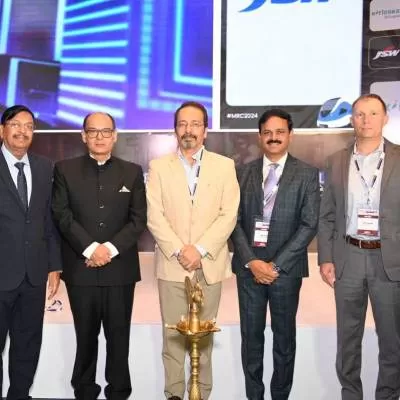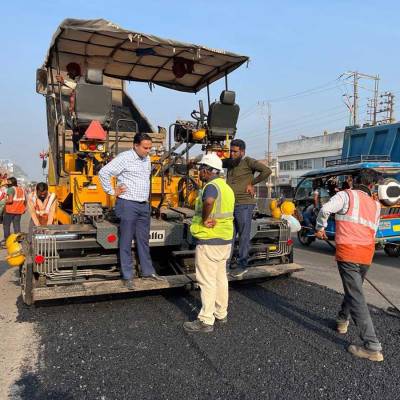- Home
- Infrastructure Transport
- ROADS & HIGHWAYS
- Gateway of opportunity

Gateway of opportunity
The Request for Qualification (RFQ) global tender for developing the new Navi Mumbai airport was recently floated in February 2014. With an area of about 1,160 hectare, the project will be among the largest greenfield airport PPP projects in India and one of the largest in the world with an airport handling capacity of 60 million passengers per annum.
The master plan envisages the project to be developed in four phases. The first phase has been planned to cater to 10 million passengers per annum and is expected to be completed by 2017. Later it will be expanded to 25 million, 45 million and 60 million in phase two, three and four, respectively.
According to Sanjay Bhatia, Vice Chairperson & Managing Director, City and Industrial Development Corporation of Maharashtra Ltd (CIDCO), "The Navi Mumbai airport is a Rs 14,700 crore project and so many materials and equipment will be required. This is a huge opportunity for vendors and suppliers." Dr S Vasudevan, Associate Director, Aerospace & Defence, KPMG, adds, "The first two phases of the project are expected to constitute the bulk of the investment required, as a large part of the fixed infrastructure including the terminal building and equipment, air traffic control (ATC) tower, runway, aprons, taxiways, office buildings, navigational aids, utilities and parking infrastructure will be set up in the initial period, allowing for scalability in subsequent phases."
Perk and gains
The proposed airport will open ample new opportunities for diverse segments in the construction industry. "The airport will provide a wide variety of business opportunities for various technology companies and equipment manufacturers including IT equipment, security systems (x-ray machines, scanners, surveillance cameras, handheld devices, alarm systems, fire safety systems), people and baggage movers (escalators, carousels), air-conditioning and ventilation systems, parking infrastructure (software, RFIDs, automation), air navigation equipment and other material suppliers who wish to participate in the airport development process," elaborates Dr Vasudevan. "It will also present opportunities for Maintenance, Repair and Operations (MRO) service providers and cargo handlers (trucking companies, mechanised equipment, cold storage, ground-handling equipment) who could leverage the demand from airlines and logistics companies to set up infrastructure at the new airport."
Krishna Murthy, Aviation Project Manager, Global Aviation Services, The Louis Berger Group, Inc, adds, "There are plenty of opportunities for local as well as international vendors and suppliers in this mega project. The cost of materials, technologies and equipment will range anywhere between 30-40 per cent of the total cost of the project. Logistics is also a vital factor as one has to obtain the right materials at the right time. Owing to this, local domestic players will have a slight edge over the others as it will also enable optimisation of the transportation cost." He continues, "The Navi Mumbai airport is aimed to be a LEED-certified building; hence, energy-efficient and environment-friendly materials and equipment will be used in this project. All the latest green technologies will be sourced." Murthy also says that as the project is planned to be developed in phases over the next 30 years (subject to growth in air traffic), opportunities will exist over its entire lifecycle to meet incremental infrastructure requirements.
And finally...
Apart from the diverse business opportunities the construction of this mammoth project will bring, it will also strengthen India's presence on the world map. Murthy concludes, "We will deliver a sustainable, passenger-convenient and easily accessible, world-class airport." It is time for India to fly higher!
Project Details
Runways: Two
Terminal building: 523,000 sq m area, including concourses
Cargo complex: 175,331 sq m
Communication, navigation and surveillance: CAT-ILS, Doppler very high frequency omni-range radar (DVOR/distance measuring equipment (DME), ASR/MSSR, ASDE/SMR, technical building with 100-m control tower
Ground lighting: High-intensity runway threshold lights, centre line and edge lights, taxiway edge lights, apron floodlights, etc.
General aviation apron area: 32,000 sq m
Low-cost carrier terminal (G+1): Two MPPA capacity; Apron area: 67,400 sq m; Terminal area: 34,500 sq m
To share your views on this special report, write in at feedback@ASAPPmedia.com
The newly proposed Navi Mumbai airport has opened the gates to business opportunities across diverse segments from the construction industry, reports AHLAM RAIS. The Request for Qualification (RFQ) global tender for developing the new Navi Mumbai airport was recently floated in February 2014. With an area of about 1,160 hectare, the project will be among the largest greenfield airport PPP projects in India and one of the largest in the world with an airport handling capacity of 60 million passengers per annum. The master plan envisages the project to be developed in four phases. The first phase has been planned to cater to 10 million passengers per annum and is expected to be completed by 2017. Later it will be expanded to 25 million, 45 million and 60 million in phase two, three and four, respectively. According to Sanjay Bhatia, Vice Chairperson & Managing Director, City and Industrial Development Corporation of Maharashtra Ltd (CIDCO), "The Navi Mumbai airport is a Rs 14,700 crore project and so many materials and equipment will be required. This is a huge opportunity for vendors and suppliers." Dr S Vasudevan, Associate Director, Aerospace & Defence, KPMG, adds, "The first two phases of the project are expected to constitute the bulk of the investment required, as a large part of the fixed infrastructure including the terminal building and equipment, air traffic control (ATC) tower, runway, aprons, taxiways, office buildings, navigational aids, utilities and parking infrastructure will be set up in the initial period, allowing for scalability in subsequent phases." Perk and gains The proposed airport will open ample new opportunities for diverse segments in the construction industry. "The airport will provide a wide variety of business opportunities for various technology companies and equipment manufacturers including IT equipment, security systems (x-ray machines, scanners, surveillance cameras, handheld devices, alarm systems, fire safety systems), people and baggage movers (escalators, carousels), air-conditioning and ventilation systems, parking infrastructure (software, RFIDs, automation), air navigation equipment and other material suppliers who wish to participate in the airport development process," elaborates Dr Vasudevan. "It will also present opportunities for Maintenance, Repair and Operations (MRO) service providers and cargo handlers (trucking companies, mechanised equipment, cold storage, ground-handling equipment) who could leverage the demand from airlines and logistics companies to set up infrastructure at the new airport." Krishna Murthy, Aviation Project Manager, Global Aviation Services, The Louis Berger Group, Inc, adds, "There are plenty of opportunities for local as well as international vendors and suppliers in this mega project. The cost of materials, technologies and equipment will range anywhere between 30-40 per cent of the total cost of the project. Logistics is also a vital factor as one has to obtain the right materials at the right time. Owing to this, local domestic players will have a slight edge over the others as it will also enable optimisation of the transportation cost." He continues, "The Navi Mumbai airport is aimed to be a LEED-certified building; hence, energy-efficient and environment-friendly materials and equipment will be used in this project. All the latest green technologies will be sourced." Murthy also says that as the project is planned to be developed in phases over the next 30 years (subject to growth in air traffic), opportunities will exist over its entire lifecycle to meet incremental infrastructure requirements. And finally... Apart from the diverse business opportunities the construction of this mammoth project will bring, it will also strengthen India's presence on the world map. Murthy concludes, "We will deliver a sustainable, passenger-convenient and easily accessible, world-class airport." It is time for India to fly higher! Project Details Runways: Two Terminal building: 523,000 sq m area, including concourses Cargo complex: 175,331 sq m Communication, navigation and surveillance: CAT-ILS, Doppler very high frequency omni-range radar (DVOR/distance measuring equipment (DME), ASR/MSSR, ASDE/SMR, technical building with 100-m control tower Ground lighting: High-intensity runway threshold lights, centre line and edge lights, taxiway edge lights, apron floodlights, etc. General aviation apron area: 32,000 sq m Low-cost carrier terminal (G+1): Two MPPA capacity; Apron area: 67,400 sq m; Terminal area: 34,500 sq m To share your views on this special report, write in at feedback@ASAPPmedia.com






















